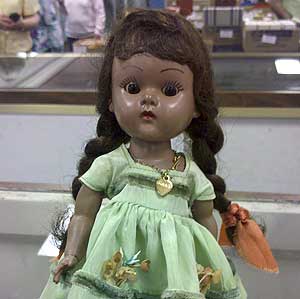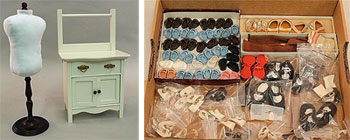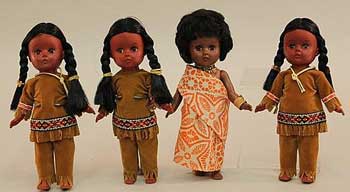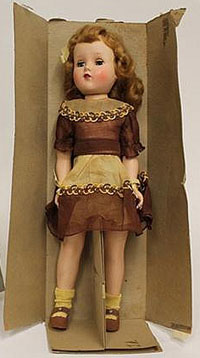From where I sat slightly behind her, I could see that the woman had crossed off items on her “dolls I want” list. Her sheet looked much like mine as we watched one male bidder snatch up doll after doll at prices we couldn’t afford.
This was my third time at the auction house’s doll sale, but I had never seen prices go this high for dolls that were not antique German bisque. Several pricey dolls – including a Lenci that was estimated at more than $1,000 – stood in a glass display case where most auction houses keep the good stuff.

The woman with the list of unrealized purchases was a collector of African American dolls whom I’d met here a few years ago. She had her eye on a black Vogue Ginny doll, she told me later. I was hoping to get a bid in on that doll, too. Click on the photo above for a full view of the doll.
Neither of us, though, could even dip our toe into the match. We watched as the bids roared past $500, then $750, and finally stopping at $950. It’s not surprising to see top bids for African American dolls, but I thought this price for a Ginny doll was stratospheric.
She was a cute little doll – Ginny dolls are adorable with their round full faces – but how rare was this one, I wondered. (The only ones I could find sold on eBay were later versions.)

“If these are going for this amount, what will the others sell for,” my auction buddy Janet said, referring to the dolls in the case.
Janet had come looking to buy a few items to stock her booth at an antiques mart. She’d seen some 1970s Ginny dolls and a few accessories that she figured she could get for 30 bucks or so. Was she wrong!
The prices were horrendously high for me, especially since I go to auctions to buy cheap, and I found the process frustrating. This auction was no fun at all, because there wasn’t any chance of buying anything.

The auction lacked a variety of dolls, doll parts and accessories. Most of the dolls were in the Vogue Ginny, Jill, Jan and Ginnette line. Some seemed to be early dolls; two were marked 1948-1949 and others 1978.
There also didn’t seem to be as many items to choose from, and I figured that was the reason for the high prices. People may have been clamoring to buy something to make the trip to the auction house worthwhile. But this one man wasn’t going to let that happen, knocking a lot of the regulars out of the bidding. We assumed that he was a dealer, and we wondered how he could turn a profit at the prices he was paying.
That may not be so hard, though, because there is a large industry of people across the world who love dolls – as collectors, restorers on their own or in their doll hospitals, and sellers. And some are willing to pay big bucks for the dolls that they want.

I’m always searching for African American dolls because for a time so few of them were made. German and French doll companies began making them in the 1800s by painting the molds they used for white dolls – thereby producing black dolls with white features. Some major U.S. doll makers also started making black dolls during the first half of the 20th century.
By the 1960s, African American companies began producing dolls with natural features, starting with Shindana and Beatrice Wright in the 1960s.
Vogue made its black Ginny in 1953, according to one doll reference site. The earliest Vogue style of Ginny was made in 1948 as a composition doll with painted slanted eyes. Three years later, the doll became Ginny, named after the maker Jennie Graves’ daughter, Virginia. The 8″ doll was made of hard plastic, and came with clothes and accessories that could be purchased.
She was very popular and turned Vogue into a successful company. Ginny went through various changes through the 1950s, including the addition of other dolls to her family.

The strung Ginnys (ones whose arms and legs are held in place with string inside the body) with painted eyes are said to be more collectible. I was ready to buy three such dolls until they were bidded up to $150.
At auction, the clothes and accessories were just as expensive as the dolls. Here’s a sampling of what was sold:
Four boxes of Ginny clothes with the original prices of $1.50 and $3.00 stamped on them, $190.
One lot of doll clothes started at $180, and sold for $225.

Six wigs in their original packages, $300.
2 Ginny dolls that the auction house said were from 1948-1949, $700. Another lot of 3 dolls, $750.
A dozen packages of clothes that originally sold for 75 cents each, $180.
About 55 individually packaged beads/bracelets/purses, and headbands/gloves on original sales card. At some point someone had writen “50 cents each” on the package, $350.
As for the older dolls in the display case, they sold for $100 to $1,900. The most expensive was the Lenci – felt dolls that were first made around 1918 by Elena Scavini, known as Madame Lenci of Italy. In 1926, she made a Lenci doll modeled after Josephine Baker, whom she had met in Paris.


I’ve been to auctions like that. You anticipate going but are sorely disappointed. There will always be more.
Let’s hope so. I’m ready for the on-site auctions to return.